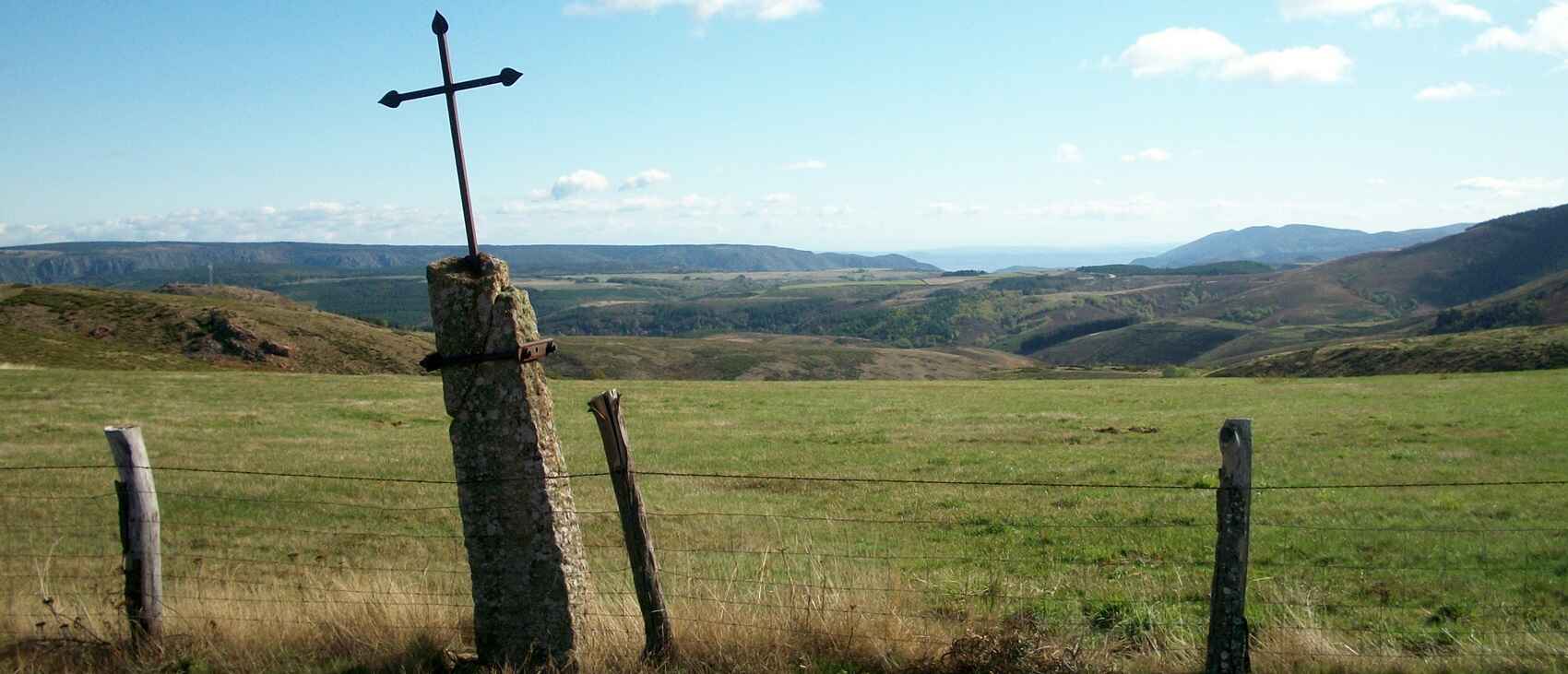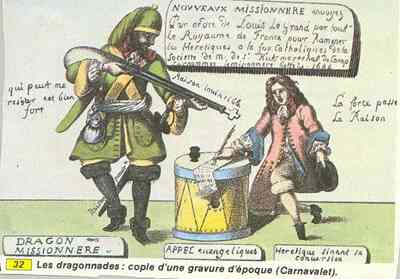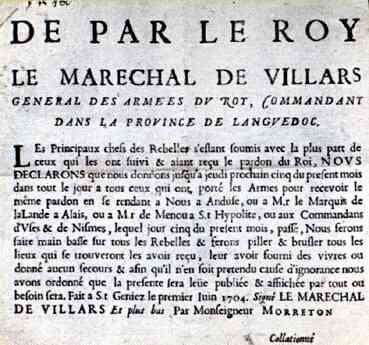The Cevennes, land of the Camisards |

 These are the places of memory of the Protestant struggle against the troops of Louis XIV. Following the revocation of the Edict of Nantes granted a century earlier by Henry IV, the Cévennes ignited, and fierce battles took place from Aigues-Mortes to Mont-Lozère. Roland's House in Mialet bears witness to this cruel epic, and a pilgrimage to this House of Remembrance (Mialet is very close to Anduze) can only penetrate the soul of those who wish to delve into the mysteries of the Camisard adventure.
These are the places of memory of the Protestant struggle against the troops of Louis XIV. Following the revocation of the Edict of Nantes granted a century earlier by Henry IV, the Cévennes ignited, and fierce battles took place from Aigues-Mortes to Mont-Lozère. Roland's House in Mialet bears witness to this cruel epic, and a pilgrimage to this House of Remembrance (Mialet is very close to Anduze) can only penetrate the soul of those who wish to delve into the mysteries of the Camisard adventure.
Arians, Waldensians, Cathars, Huguenots, never has Languedoc accepted a singular way of thinking until this day. A fierce journey in a land that has always been rebellious. Languedoc did not wait for the 16th century or Calvin to plunge into opposition to orthodoxy, and even more so to the "Francien" northern ideology.
Already its "capacity for heresy" manifested itself in the early centuries after Jesus Christ when the Visigoths arianized the southern half of Roman Gaul. Meyrueis, for example, was under the domination of a Visigoth count at the beginning of the 5th century.
 This Arians' hold (a very dichotomous doctrine that posits a God who is always divine and a Christ who is entirely human), challenged multiple times by the Franks of Clovis (victory at Veuille in 507), nevertheless maintained itself in Languedoc within the ancient Roman Septimania, including Meyrueis, Florac, and the Borgne Valley, at least until the arrival of the Saracens who invaded our region around the year 720 and remained there for eighty years until Pepin the Short and Charlemagne. The latter would "pass again" by military force into Spain, liberating notably Barcelona, which he made a Frankish county, a "march" that encompasses all of Lower Languedoc (including Gévaudan) and Catalonia.
This Arians' hold (a very dichotomous doctrine that posits a God who is always divine and a Christ who is entirely human), challenged multiple times by the Franks of Clovis (victory at Veuille in 507), nevertheless maintained itself in Languedoc within the ancient Roman Septimania, including Meyrueis, Florac, and the Borgne Valley, at least until the arrival of the Saracens who invaded our region around the year 720 and remained there for eighty years until Pepin the Short and Charlemagne. The latter would "pass again" by military force into Spain, liberating notably Barcelona, which he made a Frankish county, a "march" that encompasses all of Lower Languedoc (including Gévaudan) and Catalonia.
The spiritual reconquest of our territory by Catholicism was carried out through Benedictine monasteries, rationally established in the 9th and 10th centuries (cf. Saint-Guilhem, Aniane, Nant...). But this establishment, this almost conquering occupation of the land, is felt by the Languedoc populations as a foreign, Germanic, and barbaric occupation. The independentist Languedoc is in a malaise...
Two new heresies would share the favors of regional irredentism: Valdism (originating from Lyon and spreading to Vivarais, Cévennes, and throughout Provence) and, of course, Catharism, more centered on the axis of Carcassonne, Albi, Toulouse.
Peter Waldo (born around 1150), a wealthy merchant from Lyon, like Saint Francis of Assisi, suddenly converts, sells all his possessions (if you wish to be perfect...) and sets out to preach on the roads. The official Church views this approach with great disfavor, especially as the Waldensian disciples, more royalists than the king, accuse this same Church and its clergy of being a tool of the devil, of having completely forgotten evangelical poverty, and of concealing the texts that "disturb." However, as "it is right to obey God rather than men," the Waldensians preach a return to the sources of Christianity and the Gospel outside any ecclesiastical structure. Quickly chased from all sides, they hide, notably in Piedmont and in the Cévennes valleys where they will sow the ground for the future Reformation, closely related in its beginnings to Waldism.
 For this movement, which appeared in the middle of the 16th century in Languedoc, will spread like wildfire across the entire Cévennes and Lower and Upper Languedoc. The Huguenot party quickly finds lords, armies, and fortified cities, bastions extorted or granted by the power as per the treaties signed throughout the 16th century. Massacres are organized on both sides. Thus, Gévaudan is systematically ravaged by Captain Merle who (in all simplicity) destroys stone by stone the cathedral of Mende, the town of La Canourgue, while the Catholic party pillages Marvejols and massacres those of the "Religion" as in Vassy in 1562 or during the Saint Bartholomew's Day massacre (1572).
For this movement, which appeared in the middle of the 16th century in Languedoc, will spread like wildfire across the entire Cévennes and Lower and Upper Languedoc. The Huguenot party quickly finds lords, armies, and fortified cities, bastions extorted or granted by the power as per the treaties signed throughout the 16th century. Massacres are organized on both sides. Thus, Gévaudan is systematically ravaged by Captain Merle who (in all simplicity) destroys stone by stone the cathedral of Mende, the town of La Canourgue, while the Catholic party pillages Marvejols and massacres those of the "Religion" as in Vassy in 1562 or during the Saint Bartholomew's Day massacre (1572).
Languedoc, already severely tested by the Hundred Years' War and the Great Plague, depletes its last reserves in these fratricidal struggles with strong political and social connotations. Although the Edict of Nantes by Henry IV (1598) temporarily calms the situation, mistrust persists and the political use of religious antagonisms remains frequent. The dismantling of Protestant strongholds will be the work of Richelieu (siege of La Rochelle and then the Treaty of Alès in 1630). Meyrueis itself will suffer the wrath of the Catholic royal army, witnessing its castle (the Rocher) razed and the towers of the castles of Roquedols and Ayres beheaded as a form of humiliation. Thus, by the end of Louis XIII's reign, Protestantism finds itself without any support other than its inner conviction and freedom to practice. The Edict of Nantes is already considerably undermined.
 The persecution of Protestantism in France finds its counterpart in England where minority Catholics (as well as the Irish) are hunted. Charles I of England is beheaded in 1649 by Cromwell and his Presbyterian troops... The lesson will be learned in France. Louis XIV, unwilling to suffer the same fate, will implement a whole system of constraints to reduce (or even eradicate) this Pretended Reformed Religion (prohibitions on certain professions, taking on apprentices, celebrating worship outside closed places, burying the dead between six in the morning and seven in the evening...).
The persecution of Protestantism in France finds its counterpart in England where minority Catholics (as well as the Irish) are hunted. Charles I of England is beheaded in 1649 by Cromwell and his Presbyterian troops... The lesson will be learned in France. Louis XIV, unwilling to suffer the same fate, will implement a whole system of constraints to reduce (or even eradicate) this Pretended Reformed Religion (prohibitions on certain professions, taking on apprentices, celebrating worship outside closed places, burying the dead between six in the morning and seven in the evening...).
Thus, as early as the 1660s and 1670s, bourgeois and artisans began to emigrate to the Palatinate, Württemberg, and Savoy where they find their Waldensian brothers. Languedoc gradually empties of its economic strength, often Protestant. This emigration has been estimated at 300,000 people. In the Cévennes and the Languedoc hinterland, primarily rural, fierce, and poor Protestantism remains, secluded in its valleys.
By the 1680s, forced conversions accelerate, especially in cities like Nîmes and Montpellier. In the countryside, the king's dragoons occupy Protestant towns, "missionaries" wielding a hegemonic form of Catholicism.
It is in 1685, under the influence of the Marquise de Maintenon, that Louis XIV, concluding that there was no longer any reason to allow Protestantism to be practiced since there were no longer any Protestants (c.q.f.d.), revokes the Edict of Nantes and decides to destroy all temples since they can serve no purpose!
 In our region, the conduct of operations is entrusted to the Inspector of Missions in the Cévennes, Abbé du Chayla, tasked with converting or arresting the recalcitrant, notably "those who prevent going to mass," the "psalm singers," the "pastors and seditious." A hard task! Often military or police in nature. Christian charity has a hard time finding its place...
In our region, the conduct of operations is entrusted to the Inspector of Missions in the Cévennes, Abbé du Chayla, tasked with converting or arresting the recalcitrant, notably "those who prevent going to mass," the "psalm singers," the "pastors and seditious." A hard task! Often military or police in nature. Christian charity has a hard time finding its place...
Abbé du Chayla, the main architect of this great cleansing, imprisons and tortures in all good conscience in his headquarters at Pont-de-Montvert to obtain these famous "ultimate" conversions. He is attacked and killed in 1703 by Esprit Seguier, determined to rescue the abbey's prisoners. This action will trigger the War of the Cévennes, known as the Camisard War (from camisade: the great white shirt worn by the rebels to recognize each other).
The three main Camisard armies are located one on Mont Aigoual with its headquarters near Vébron (halfway between Meyrueis and Florac) led by Castanet; another in the lower Cévennes led by Pierre Laporte, called Rolland; the third around Nîmes with Cavalier. A fourth band holds Mont Lozère with Mazel, Couderc, Joany.
This guerrilla war, characterized by ambushes and sudden strikes, completely confuses the Intendant of Languedoc, Monsieur de Basville, as well as the leaders of the royal army dispatched to the area: Broglie, Montrevel, and finally Villars after the failure of the two previous leaders.
The relentless resistance (or even victories) of these Protestant peasants drives the leadership of this army mad, notably the notoriously infamous Captain Poul, Baron de Saint Cosme (a former Huguenot convert) or Julien, the victor over Rolland at the battle of Vagnas. We should also mention Brigadier Planque, "famous" for ravaging the land of Valleraugues and the Borgne Valley.
Before each of the battles, the Camisards, one knee on the ground, sing the battle psalm:
Let God show Himself only
And we will see suddenly
Abandon the place
And flee before His face
And melt from all sides
The camp of the scattered enemies.
God will make them all flee
As one sees evaporating
A mass of smoke.
The strength is consumed
Of the enemies before God
Like wax before the fire.
 The battles are often indecisive but the rebels are mostly elusive.
The battles are often indecisive but the rebels are mostly elusive.
Basville will draw two major "penetrating" routes through the Cévennes to allow his troops to move; notably the road of the Corniche des Cévennes, overlooking the valleys to avoid constant ambushes. Also near Vébron, the road of the Cardinale...
In the impossibility of curbing the rebellion, Basville will organize the "Grand Breulement des Cévennes" so that the Camisards can no longer feed or rest. Villagers are gathered in a few large fortified towns, and all hamlets, villages, and small farms scattered throughout the valleys are demolished or burned. An entire region will be ravaged, destroyed in order to bring down two or three thousand rebels! Imprisonments, sentences to the galleys, torture, and savage executions will follow until 1704, when Marshal de Villars finally manages to negotiate with the most powerful of the Camisard leaders, Cavalier, for the release of all those condemned, the possibility of practicing his religion at least at home, and tax exemptions for those whose houses have been destroyed.
But the revolt, although it weakens, does not cease as other Camisard "generals," such as Rolland, want to die with arms in hand, not believing the promises of such a cruel power. That is indeed what happens. Gradually, the groups diminish, the leaders die or are captured, the promises of release not being respected due to the fact that total surrender has not been obtained...
The endemic persecutions will continue until the middle of the 18th century. But it will take until Louis XVI, who in 1787 signs an Edict of Tolerance granting Protestants civil status, the possibility of marrying outside the official Church, and of course, the freedom of worship...
Former holiday hotel with a garden along the Allier, L'Etoile Guest House is located in La Bastide-Puylaurent between Lozere, Ardeche, and the Cevennes in the mountains of Southern France. At the crossroads of GR®7, GR®70 Stevenson Path, GR®72, GR®700 Regordane Way, GR®470 Allier River springs and gorges, GRP® Cevenol, Ardechoise Mountains, Margeride. Numerous loop trails for hiking and one-day biking excursions. Ideal for a relaxing and hiking getaway.
Copyright©etoile.fr